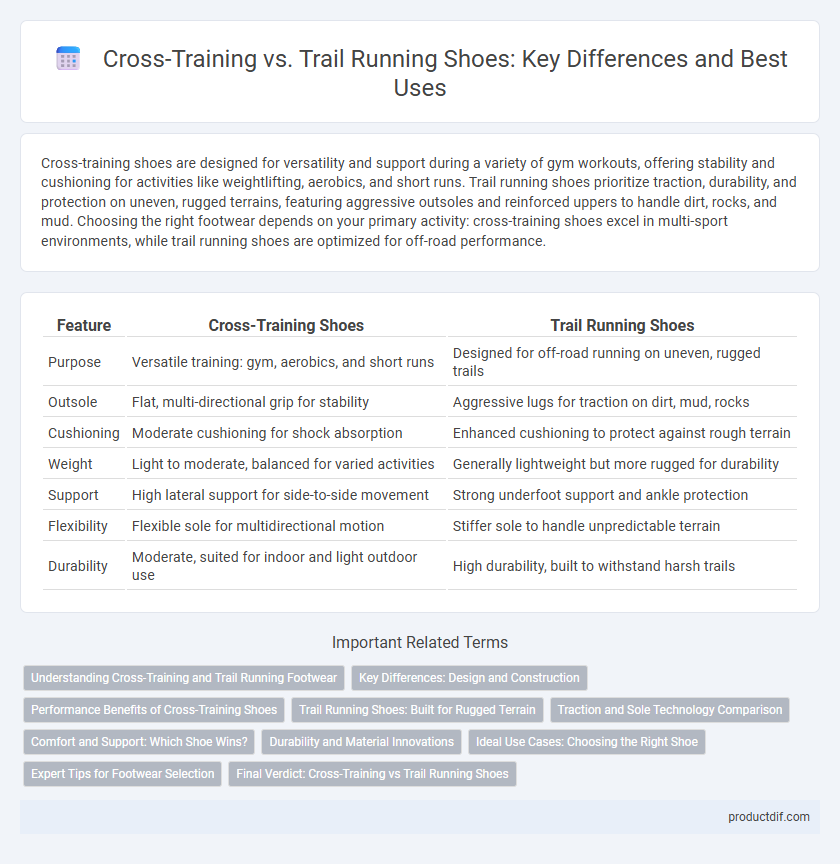Cross-training shoes are designed for versatility and support during a variety of gym workouts, offering stability and cushioning for activities like weightlifting, aerobics, and short runs. Trail running shoes prioritize traction, durability, and protection on uneven, rugged terrains, featuring aggressive outsoles and reinforced uppers to handle dirt, rocks, and mud. Choosing the right footwear depends on your primary activity: cross-training shoes excel in multi-sport environments, while trail running shoes are optimized for off-road performance.
Table of Comparison
| Feature | Cross-Training Shoes | Trail Running Shoes |
|---|---|---|
| Purpose | Versatile training: gym, aerobics, and short runs | Designed for off-road running on uneven, rugged trails |
| Outsole | Flat, multi-directional grip for stability | Aggressive lugs for traction on dirt, mud, rocks |
| Cushioning | Moderate cushioning for shock absorption | Enhanced cushioning to protect against rough terrain |
| Weight | Light to moderate, balanced for varied activities | Generally lightweight but more rugged for durability |
| Support | High lateral support for side-to-side movement | Strong underfoot support and ankle protection |
| Flexibility | Flexible sole for multidirectional motion | Stiffer sole to handle unpredictable terrain |
| Durability | Moderate, suited for indoor and light outdoor use | High durability, built to withstand harsh trails |
Understanding Cross-Training and Trail Running Footwear
Cross-training shoes offer versatile support and cushioning suitable for varied gym workouts and agility drills, featuring durable soles and stable midsoles for multidirectional movement. Trail running footwear prioritizes enhanced grip with aggressive tread patterns, reinforced toe caps, and water-resistant materials designed for uneven, rugged terrains. Understanding the differences in sole design, weight, and protective features helps athletes select the optimal shoe for cross-training or trail running activities.
Key Differences: Design and Construction
Cross-training shoes feature a low-profile design with multidirectional traction suited for gym workouts and smooth surfaces, offering flexibility and lateral support. Trail running shoes are constructed with rugged soles, reinforced toe caps, and waterproof materials to enhance grip and protection on uneven, rocky terrain. The key difference lies in cross-trainers emphasizing versatility and stability for mixed activities, while trail runners prioritize durability and traction for off-road performance.
Performance Benefits of Cross-Training Shoes
Cross-training shoes provide versatile performance benefits, combining stability, support, and cushioning to enhance various physical activities beyond running, such as weightlifting and high-intensity interval training. Engineered with durable outsoles and multi-directional tread patterns, they offer superior traction and lateral support compared to trail running shoes, which are optimized primarily for grip on uneven terrain. Their balanced design promotes injury prevention and improved agility, making them ideal for athletes engaging in diverse workout routines.
Trail Running Shoes: Built for Rugged Terrain
Trail running shoes feature aggressive tread patterns and reinforced toe caps designed to withstand rocky, uneven surfaces while providing superior grip on mud, gravel, and roots. Engineered with durable materials and enhanced cushioning, these shoes absorb impact and protect feet from sharp obstacles found in natural, rugged environments. Their stability features reduce the risk of ankle injuries, making them essential for off-road runners navigating challenging trails.
Traction and Sole Technology Comparison
Trail running shoes feature aggressive lug patterns and durable rubber compounds designed to maximize traction on uneven, muddy, or rocky terrains, providing superior grip and stability. Cross-training shoes utilize flatter, multi-directional soles engineered for versatile support and grip on indoor or gym surfaces, prioritizing lateral movement rather than rugged outdoor traction. Advanced sole technologies in trail running often include rock plates and sticky rubber outsoles, enhancing protection and traction, whereas cross-training soles emphasize flexibility and cushioning for diverse workout activities.
Comfort and Support: Which Shoe Wins?
Cross-training shoes excel in comfort and support by offering ample cushioning and stability for diverse workouts, making them ideal for gym sessions and short runs. Trail running shoes provide superior grip and protection with rugged soles and reinforced toe caps, enhancing comfort on uneven terrains but potentially sacrificing all-day softness. For those prioritizing consistent cushioning and multi-surface support, cross-training shoes win, while trail runners dominate in off-road durability and terrain-specific comfort.
Durability and Material Innovations
Cross-training shoes are designed with reinforced synthetic uppers and durable rubber outsoles to withstand varied gym workouts, offering high abrasion resistance for multi-surface durability. Trail running shoes incorporate advanced materials like rock plates, rugged Vibram soles, and water-resistant meshes to enhance durability against rough terrains and harsh weather conditions. Innovations such as reinforced TPU overlays and breathable yet tough knit fabrics improve longevity while maintaining lightweight performance for both categories.
Ideal Use Cases: Choosing the Right Shoe
Cross-training shoes excel in versatility for gym workouts, aerobics, and short-distance running, providing multi-directional support and cushioning. Trail running shoes are designed for off-road terrain, featuring enhanced grip, durability, and protection against rocks and uneven surfaces. Selecting the right shoe depends on activity type: choose cross-training shoes for varied indoor and outdoor workouts, and trail running shoes for rugged trail conditions and longer outdoor runs.
Expert Tips for Footwear Selection
When selecting footwear for cross-training versus trail running, experts emphasize the importance of support and traction tailored to each activity. Cross-training shoes should offer multi-directional stability and cushioning to handle varied gym movements, while trail running shoes require rugged outsoles with deep lugs for grip on uneven, slippery terrain. Key factors include assessing arch support, sole durability, and overall fit to enhance performance and reduce injury risk in both disciplines.
Final Verdict: Cross-Training vs Trail Running Shoes
Cross-training shoes offer versatile support and cushioning designed for varied gym workouts and indoor activities, prioritizing lateral stability and multi-surface traction. Trail running shoes provide specialized features such as aggressive outsole lugs, enhanced toe protection, and robust waterproofing to tackle uneven, rugged terrain and wet conditions. For athletes seeking all-around performance and flexibility, cross-training shoes are optimal, while trail runners demanding durability and grip on technical trails benefit most from trail-specific footwear.
Cross-training vs Trail Running Infographic

 productdif.com
productdif.com